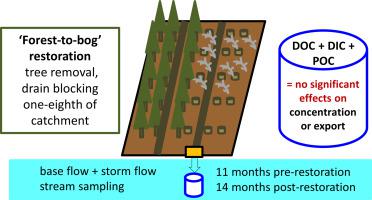Science of the Total Environment ( IF 8.2 ) Pub Date : 2020-06-30 , DOI: 10.1016/j.scitotenv.2020.140594 Paul P J Gaffney 1 , Mark H Hancock 2 , Mark A Taggart 1 , Roxane Andersen 1

|
Peatland restoration is undertaken to bring back key peatland ecosystem services, including carbon storage. In the case of drained, afforested blanket peatlands, restoration through drain blocking and tree removal may impact upon aquatic carbon concentrations and export, which needs to be accounted for when considering the carbon benefits of restoration.
This study investigated concentrations and export of aquatic carbon from a drained, afforested blanket bog catchment, where 12% of the catchment underwent drain blocking and conifer removal (termed ‘forest-to-bog’ restoration), and from two control catchments: one in open bog and one that remained afforested. Using a before-after-control-impact (BACI) design, we found no significant increases in concentrations or export of aquatic carbon (DOC, POC or DIC) in the first year following forest-to-bog restoration (i.e. across the whole post-restoration period). However, increased DOC concentrations were observed in the first summer (2015) post-restoration, and seasonally increased DOC export was noted during storm events in the autumn of the same year. The lack of significant effects of forest-to-bog restoration on aquatic carbon export may be a consequence of the small proportion of the catchment (12%) undergoing management. In terms of management, the removal of more of the forestry residues (i.e., brash) may help to mitigate effects on aquatic carbon, by removing a potential DOC and POC source. Restoring small areas at a time (≤12%) should result in minimal aquatic carbon export issues, in contexts similar to the current study.
中文翻译:

绿化泥炭地的恢复:对水生碳损失的即时影响。
进行泥炭地恢复工作是为了恢复重要的泥炭地生态系统服务,包括碳储存。在排水,绿化的覆盖泥炭地的情况下,通过排水渠堵塞和树木砍伐进行的恢复可能会影响水生碳的浓度和出口,这在考虑恢复的碳效益时必须加以考虑。
这项研究调查了排水的,绿化的毯状沼泽流域的水生碳的浓度和出口,其中有12%的流域进行了排水阻塞和针叶树的清除(称为“森林到沼泽”的恢复),以及两个控制流域:打开沼泽和一个仍然绿化。使用控制后影响之前(BACI)的设计,我们发现在森林到沼泽恢复后的第一年(即在整个后期),水生碳(DOC,POC或DIC)的浓度或出口没有显着增加。 -恢复期)。但是,恢复后的第一个夏天(2015年)观察到DOC浓度增加,并且在同年秋天的暴风雨期间注意到DOC出口量季节性增加。森林到沼泽的恢复对水生碳出口缺乏显着影响可能是由于流域管理的一小部分(占12%)的结果。在管理方面,通过去除潜在的DOC和POC来源,去除更多的林业残留物(即肉类)可能有助于减轻对水生碳的影响。在与当前研究类似的背景下,一次恢复小面积(≤12%)应该可以将水生碳出口问题降到最低。











































 京公网安备 11010802027423号
京公网安备 11010802027423号